
Candida Martinelli's Italophile Site

Main
Page This family-friendly site celebrates Italian culture for the enjoyment of children and
adults. Site-Overview
The
wonderful cookbook by food historian Donatella Cirri Martelli, La
vera cucina italiana (The True Italian Cuisine, Editoriale
Olimpia, 1980) provides entertaining and
edifying information on many Italian dishes and Italian cuisine in
general. If
you have the chance to get a copy of the book, I highly recommend it
for her erudition, passion for Italian cuisine, and her impeccable
Tuscan Italian. Below are summaries
of some of the information she includes, per section, along with a
few translated recipes. I've added other recipes from around
my site to this page, too. La
pasta asciutta - Dried Pasta La
pasta fatta in casa - Fresh Pasta (Homemade Pasta) Risotto,
Minestre, Zuppe, Polenta - Rice Dishes, Stews, Soups, Polenta Pizze,
Focacce, Torte salate - Pizzas, Flat
Breads (Pizza Breads), Savory Pies La
carne, Il pollo, Il pesce, Piccola salumeria casalinga
- Meat, Chicken, Fish, Homemade Cured Meats Le
verdure, La verdure sott’olio e sott’aceto, Le uova
- Vegetables, Vegetables preserved in oil and vinegar, Eggs I
dolci, I gelati, La frutta conservata, I liquori
- Desserts, Ices, Preserved Fruit, Liquors One
of the oldest of these recipes is for La panzanella, a
bread-based salad. It was
usually made with the week’s leftovers, because no food could afford
to be wasted. I usually
make it during the summer months, because it is delicious and
refreshing, and very easy to make. 500 grams of bread, preferably whole grain, and a few days old 4
very ripe tomatoes 2
red onions 4
tablespoons of olive oil 2
tablespoons of vinegar Chopped
fresh basil Salt and pepper to taste The
key to the dish is the soaking of the bread, diced, in cold water for
half an hour. Then you
wring it out with your hands and crumble it into a big mixing bowl.
Then you add the other ingredients, mix, and set it in the
fridge for at least two hours. She
includes a very old recipe for liver pate or Pasticcio freddo di
fegato, and explains that it has it’s origins in the Italian
Renaissance (Il Platina, again, and Cristoforo da Messiburgo in Banchetti,
composizione di vivande et apparecchio generale from Ferrara in
1549) when it was almost always used as filling for a meat pie. Only in the summer months was it used as a spread on bread or
crackers, as we use it today. 200
grams of veal liver (diced) 200
grams of chicken livers 100 grams of raw ham 120 grams of butter 1 egg yolk 1 tablespoon of cognac or aquavit 1 tablespoon of anchovies Sage leaves Two cloves of garlic Salt, pepper to taste Cook
the livers in 20 grams of the butter, and with the sage and the garlic
cloves. When they are done, put them in a mixing bowl and discard the
sage and garlic. Add the
ham, egg yolk, cognac and anchovies.
Mix well, then add the rest of the butter, softened, and mix
until you have a consistent cream of liver pate. Fett’unta
is as old as bread. It means 'bread-soaked', in olive oil.
Garlic bread as known outside of Italy, is not eaten in Italy.
Instead they make this recipe and it's variations, called Bruschetta. Bread
slices Extra
virgin olive oil Garlic
cloves Salt
and pepper Toast
the bread slices. Rub the
garlic cloves over the toasted bread.
They will dissolve into the bread.
Put the bread slices on a plate and season them with salt and
pepper. Then pour the
olive oil over them. Eat
while the slices are still crisp and warm. Variations: Prepare
the Fett’unta as described above, and then cover them with one or
more of the following toppings. Place
the bread slices in the oven for 5 to 10 minutes until the toppings
are melted or cooked. They
need less cooking time if you place the slices under a grill. Grated
or thinly sliced cheese of any kind Capers Thinly
sliced onion rounds Bits
or slices of meat of any kind Sliced
or minced mushrooms Fresh
or dried oregano, sage or rosemary Tomato
paste or sauce Cooked
beans in a sauce Thinly
sliced or diced vegetables
Even
though the old texts use the term lasagna, they actually refer
to something more like tagliatelle.
Spaghetti comes from the Napels region, and most regions have a
traditional pasta shape. Maestro
Martino’s De arte coquinaria from 1450 has recipes for vermicelli
and maccheroni. The
story of pasta coming from China is a myth. The
earliest seasonings for the cooked pasta were meat sauces, milk,
butter, cheese, vegetables, and only after the arrival of the tomato
from the New World, and then some time to be convinced it wasn’t
poisonous, did tomato find it’s ideal partner in pasta.
Practically every family in Italy has a favorite sugo or
salsa for their pasta, so I won’t waste time putting one
here. But I will put a
recipe for an older pasta sauce, originally Italian (with some
variation in ingredients) and now considered French:
La besciamella (white sauce).
The Medici called it colla, which means glue, and when
it cools it is very glue-like, but when it is warm it makes a rich and
exotic pasta sauce. 50
grams of butter 4
tablespoons of white flour ½
liter of milk or chicken broth (milk for vegetable pastas, half/half
for meat and fish pastas) 50
grams of grated Parmesan cheese Salt
to taste Grated
nutmeg Most
recipes have you melt the butter, then add the flour, and then slowly
whisk in the hot liquid. I
find that unnecessarily laborious and too often end up with balls of
flour. I never have a
problem when I start with cold liquid, whisk in the flour, then heat
it up slowly, whisking as it cooks.
After a low boil, whisking continually, for about 5 minutes, it
is usually ready. Remove
it from the heat and add the butter and cheese and stir until they
melt. Then add the salt
and nutmeg to taste. To
give you an idea of how much nutmeg you might use, I like a lot of
nutmeg, which usually means about ½ a teaspoon. Penne
are thick tubes of pasta about as long as your thumb.
They hold up well to strong flavors and retain their chewy
texture even when not served immediately.
Cook them according to the instructions on the package, which
should indicate the number of minutes they should be boiled in salted
water. Variations: Cream
and Ham Sauce:
Melt a few tablespoons of butter in a pot over a medium heat,
then add fresh cream and let it evaporate a bit on a high heat for at
least 5 minutes. Add
diced cooked ham, the cooked Penne, grated Parmesan cheese,
salt and pepper to taste. Let
it cook just a few minutes more, stirring continually.
Adjust the amounts of cream and ham to suit your personal
tastes and the amount of pasta the sauce is to cover. Cream,
Ham and Pea Sauce:
Cook the sauce as described above.
When you add the cooked Penne, add cooked peas to the
sauce as well. Cream,
Garlic and Mushroom Sauce:
Melt a few tablespoons of butter in a pot over a low heat and
add chopped garlic cloves to personal taste.
Cook for a few minutes, then add fresh cream and let it
evaporate a bit on a high heat for at least 5 minutes.
Add chopped, sautéed mushrooms and the cooked Penne,
and season with salt and pepper to taste.
Let it cook just a few minutes more, stirring continually.
Adjust the ingredient amounts according to your personal tastes
and the amount of pasta the sauce is to cover. Just
one last word, concerning the cold-water-on-cooked-pasta debate.
Ms. Martelli, in her authoritative voice, says that one cup of
cold water thrown over just cooked pasta, works well as a break on
cooking, long enough to get the pasta seasoned and served up at table.
But you should never rinse the cooked pasta under running water
because you lose the flour-water coating that has formed over the
pasta, which helps the seasonings cling to it.
In
Ferrara they also say that tagliatelle were made to imitate the
long blond hair of Lucrezia Borgia who married Alfonso I d’Este, the
Lord of Ferrara, in 1501 (her third ‘lucky’ husband).
It is from this period that tagliatelle were a part of
all the great banquets. Tomato
is added to pasta to make red pasta.
Spinach is added to make green pasta.
Ms. Martelli describes a patriotic tri-colore
(tri-color) dish that some people serve on patriotic occasions.
All three colors of tagliatelle are prepared, and then
they are seasoned with three different colors of sauces.
For example, on the serving dish you would see white pasta with
tomato sauce, the green pasta with white sauce (besciamella),
and the red pasta with a green sauce (pesto). To
make fresh pasta at home, one must have a pasta machine to create the
sheets, a rolling board, a rolling pin, patience, patience and more
patience. And as with all
artistry, practice makes perfect.
So the only recipe I’ll put here is one Ms. Martelli calls Gnocchi
di spinaci or malfatti alla fiorentina, because it requires
none of these things. It
is typically served during Lent. 1 kilo freshly cooked spinach, all moisture removed, chopped finely 500 grams of fresh ricotta cheese 200 grams of grated Parmesan cheese 2 large eggs, or 3 small ones Ground nutmeg (1/2 teaspoon or so) Salt to taste Mix
together the chopped spinach, cheeses, eggs, nutmeg and salt.
Shape small balls of the pasta, then lightly flour them.
Cook them in boiling water until they float.
Remove them and season them immediately and serve.
A simple seasoning is best, like melted butter with some sage
and Parmesan cheese. But
you can use a tomato sauce if you prefer. Ms.
Martelli reminds the reader that pasta is not the only first course
dish in Italian cuisine. It may be one of the most unique and best know abroad, but in
Italy, it is not a fixture at every Italian’s lunch. Alternating with pasta as first course are rice dishes
(risotti), polenta, and a wide variety of soups (stews, broths, soups,
cream-soups). Rice
dishes date from the twelfth century, having come from Chine via the
Silk Road, brought by traveling monks and planted in 1150.
It is easily cultivated in the Po Valley (Vermicelli, Lombardy,
Piedmont), and is the basis of many of the most famous northern first
course dishes (rice with just about every vegetable imaginable), and
desserts (for which the rice is cooked in milk).
Italian cuisine uses short-grain rice rather then the preferred
long-grain used in the Orient. Short-grain
rice absorbs more seasonings because of it’s glutinous
coating. It’s
tastier. Polenta
has an even older origin, if with various grains, dating from the
pre-Roman Etruscan period. However,
it is probably as old as the cultivation of grain itself, ten thousand
years old. It is the mainstay of many of today’s populations in the
poorest regions of the planet, especially made with sorghum, a grain
used by the Etruscans for their pultes, polentas. Grain
grows best in Italy’s northern regions (Veneto, Lombardy), and it is
here that polenta is most eaten.
But even the winter-cold central regions enjoy the dish,
usually served with hearty game sauces.
It can vary in color from grey to orange.
Before maize (cornmeal) was brought from the New World,
polentas in Italy were made from gran-turco (gran-saraceno) -
Durham Wheat, the grain that is used for couscous, a similar dish
eaten throughout North-Africa. Polenta
is eaten freshly cooked with a sauce poured over it, or sliced up
after it has cooled, and then baked in the oven with various
ingredients between layers of polenta slices.
The following is one such recipe. 300
grams of sliced, cooked polenta 100
grams butter, diced 100
grams of grated Parmesan cheese 100
grams of grated Gruviere cheese Besciamella
(see above) Layer
the polenta slices in a buttered dish, alternated with the other
ingredients. Make sure
you don’t finish with the polenta slices on top.
Then cook it in a hot oven for at least 10 minutes.
You can season it with sage or diced ham if you like between
the layers. Soups
have been the mainstay of the poor since the beginning of time.
The broth base can be made from leftover animal bones, and the
soup ingredients can be leftovers of meat, vegetables, and even bread.
The richer variety of soup, the cream-soups, date from the
Italian Renaissance. Interestingly,
the oldest Italian soups contain boiled bread, as it was the tradition
in the Middle-Ages to serve meals to the gentry on unleavened bread,
and then the servants boiled up all the leftovers, including these
early versions of pizzas, as their one meal of the day. Focacce
remained popular throughout the middle ages, and each region of Italy
made local versions, with local names. The
Latin dialects became the Italian dialects, and the names remained.
These are the various names used today in Italy for the
regional variations: focaccia,
cavaccino, pizza, pitta, impanata, calzoni, panzerotti, etc.
They are known around the world, but like all of Italian
cooking, there are few rigid rules about how to make them.
The individual creativity of the cook is encouraged.
In Italy, cooking truly is a creative outlet. 1
cup lukewarm milk 1
package yeast 1
tbsp sugar 1tsp
salt 3
tbsp olive oil Approx.
2 ½ cups flour In
a room temperature glass or crockery bowl, dissolve the yeast in the
milk, then mix in the sugar, salt, and oil with a wooden spoon. Add the flour until the dough forms a compact ball.
Roll out the dough to ¼ inch thick and place on an olive-oiled
oven tray. Press firmly
with your fingertips to make indentations in the dough.
Cover with a clean tea towel and let it rise to double in
height. This should take
only 1 hour if you keep the tray in a warm, draft-free place.
This is the basic Foccace dough.
Below are various toppings to add to the risen bread before it
is cooked in a hot oven for roughly 10 minutes, or until the crust is
golden. Toppings: Olive
Oil: Pour olive oil over the dough and spread it around with your
fingers to cover the entire surface.
Then sprinkle the dough lightly with salt. The fruitier the oil, the tastier the bread. Olive
Oil and Rosemary:
Prepare the dough with the previous topping and then sprinkle
it with chopped fresh or dried rosemary. Onion
and Cheese:
Cover the dough with cooked onions and then sprinkle with
grated cheese. Tomato:
Cover the dough with a tomato pasta sauce and then drizzle
olive oil over the top. Raisons: Add raisons to the dough just before you roll it out to rise.
After the rising, cover the dough with olive oil and salt as
described for the Olive Oil topping. One
of the classic savory pies is La torta Pasqualina, The Easer
Pie. The time before
Easter is Lent, when the Catholic church forbade the eating of meat
and eggs. So when Easter
came, ending the restrictions of Lent, it was customary to celebrate
with eggs dishes, also because eggs signify rebirth.
You find the same tradition in orthodox Christian customs, too.
This pie is from the Lombard region of Italy. Pie crust for a double-crust pie 400
grams of cooked and finely chopped spinach 300
grams of fresh ricotta cheese 6
eggs 100
grams of grated Parmesan cheese Parsley,
2-3 tablespoons Marjoram,
a pinch Sale
and pepper, about one teaspoon of salt and ½ of pepper Butter
a round casserole dish, then line it with the crust.
Mix together the spinach, cheeses, two eggs, parsley, marjoram,
and salt and pepper. Put
the filling in the crust. Then
use a spoon to form four pockets in the filling.
Put one egg in each, raw, but without the shell (different from
the Greeks who cook the eggs with the shells in Easter breads!).
Then put the top crust on, seal it, brush it with olive oil. Cook it in a moderate over for roughly an hour and ½.
If the top cooks too quickly, cover it with aluminum foil.
It is best eaten warm or cold, but never hot. Romans
prided themselves on their dietary frugality, and ate meat rarely
during any week. When they did eat meat, it was not beef, cows and bulls being
too valuable in agriculture and the production of milk. They ate pork, chicken and wild fowl (that too has
disappeared after the flood-plains were drained).
Slaves, over half of the Roman-era population, lived on bread,
olive oil, olives, rotten fruit, and the leftovers from their
master’s table. The
middle-ages saw a worsening of diets due to the continual wars and the
insecurity economic depression that accompanied them.
Only when the Renaissance began, did the diets of the poor
improve, but while the rich ate the best parts of the beasts, the poor
had to make due with the internal organs and the ears and feet of the
animals. They created
tasty dishes that entered Italian cuisine and are still eaten today.
(The internal organs of animals butchered in the U.S. are often
shipped to Europe for sale.) I won’t put one of those recipes here, mainly because the
smell of them turns my stomach (sorry, but it’s the truth). Instead, here’s a recipe from Northern Italy. 400
grams of chicken breasts, pounded into thin fillets 400
grams of sliced mushrooms ¼
liter of cream 50 grams of butter 50
grams of flour 2
cloves of garlic, crushed salt
and pepper to taste Melt
the butter in a pan and add the garlic.
When the garlic is toasted, remove it.
Then lightly flour the chicken breasts and brown them on both
sides in the hot butter. Add
the mushrooms and cover the pan to let them cook for 10 minutes.
Then uncover the pan and raise the heat to cook off some the
mushroom liquid. Then add
the cream and cook, stirring for 10 minutes until you have a nice
thick sauce. Season to
taste with salt and pepper. (Ms.
Martelli has you add 1 teaspoon of lemon juice to the cooking
mushrooms, and season the dish at that time.
It is up to you.) Grilled
meats are very popular and the best restaurants for freshly grilled
meats are the special Grillaio restaurants that grill everything
(except the pasta!). I always seemed to find them in the
mountain villages, and you can smell them as you approach. The
wonderful aroma of the charcoal and cooking meats is their best
advertising. Pollo
alla griglia - Grilled Chicken Medium-sized
pieces of chicken either on the bone or not Vinegar
or lemon juice Crushed
garlic cloves Herbs Marinate
the chicken pieces several hours, preferably overnight, in the
vinegar/lemon juice, garlic and herbs.
The vinegar/lemon juice tenderizes the meat, and the meat takes
the flavors of the garlic and various herbs.
After marinating, dry the chicken pieces then coat them with
olive oil, and grill. Season
with salt and pepper as it cooks. Italians often use large pieces of
sage or rosemary dipped in olive oil to brush the meat as it grills to
add flavor, and to apply the oil which makes the meat crisp and brown.
The marinade should be used only to tenderize and flavor the
raw chicken, not for basting or as a sauce for sanitary
reasons. Variations: The
variations are in the herbs that you use in the marinade, or the
liquids you add for flavor. Try
various combinations to find the ones that appeal to your personal
tastes. Here are some
suggestions. Fresh
or dried sage Fresh
or dried rosemary Fresh
or dried thyme Extra
crushed garlic cloves Orange
juice Whisky,
vodka or other strong liquor Fish
has always been a staple of the Mediterranean diet, but pollution has
killed off most of the fresh water fish in Italy, and the
Mediterranean is considered, technically, a dead sea.
The result has been higher fish prices, just as the prices of
meat has come down. Even
the fish that does appear on the market is often of questionable
quality due to pollution in the seas where they are fished or farmed.
Sadly, this is not a problem unique to Italy.
The following is the simplest way to cook a fish, and if the
fish is fresh, it is the tastiest, in my humble opinion. 1
whole fish, cleaned (especially nice with trout and salmon-trout) several
cloves of crushed garlic One lemon sliced thinly 1
cup of chopped parsley Salt
and pepper to taste Set
the fish on a sheet of aluminum foil large enough to wrap it up.
Fill the fish with the garlic and parsley.
Put lemon slices inside and outside the fish.
Seal it in the foil and set it in a hot oven (on a tray is
you’d like, to catch any escaping juice) for 20 minutes or 30
minutes for a thick fish. Remove
it from the oven and foil, season with salt and pepper, and serve.
Or you can serve it and let each person season it to their
taste. Vegetables
have always been a large part of the diet of the people living on the
Italian peninsula, not only because many varieties grow wild, there,
but because their nutritive and medicinal qualities have long been
known. Potatoes
arrived from the New World in the 17th century, and quickly
became a staple of the diet of Northern Italians, especially those
living in the mountains. This
manner of cooking potatoes is the tastiest fried potatoes I’ve ever
eaten. And whatever you
do, don’t call the French Fries. Two
medium-sized potatoes per person, sliced into strips about ½ inch
thick Two
cloves of garlic, sliced in two with the skin on, if you’d like Peanut
oil (this is the best oil for frying because it can reach higher
temperatures without burning) Salt
and pepper Put
the oil in a pot and heat it up.
It is best to put it in a deep pot rather than a shallow pan.
Add the garlic and when they start to brown, the oil is
generally ready. Add the sliced potatoes, but only enough that they still have
room to float around a bit. It’s
best to cook several batches than try to cook them all at once,
because water escapes during the cooking process, and it can make the
potatoes stick together. I
like to remove the garlic when it is thoroughly cooked to avoid a
burnt taste getting in the oil. Add
some salt and pepper while the potatoes are cooking.
I decide they are done, when I think they are golden enough,
and then I wait one more minute.
They never seem to be done when I think they are, so that one
minute makes all the difference in the world.
Remove the potatoes from the oil with a strainer tool and let
them sit on paper towels for a few minutes.
Season them further now, and serve while they are still hot. Melanzane,
or egg plant, is a typical vegetable of Southern Italy because of the
warm weather needed to grow them, and because they were brought there
by the Arabs who ruled over that region for a time.
The name even comes from the Arab word for the vegetable badingian. Pepperoni,
or sweet bell peppers, are another vegetable typical of Southern
Italy, again because of the warm weather needed to ripen them, and
because the Spanish brought them there, from Brazil, when they ruled
over both regions. Greens,
like spinach, grow wild throughout Italy.
They are especially nice in this following recipe, but you can
make this dish with many other kinds of vegetables like cooked
broccoli, cauliflower, and carrots.
It’s name, sformato, means ‘misshapen’, which
I’ve always imagined referred to how the vegetables are chopped up
before cooked into a new form. It
is a simple, yet exquisitely tasting dish, that seduces even men, who
seem to have a natural aversion to vegetables. 300
grams of cooked spinach, chopped very finely Besciamella,
prepared as reported above 40 grams of butter 2
egg yolks Salt
and pepper, about 1 teaspoon salt and ½ teaspoon of pepper A
pinch of nutmeg, about ¼ teaspoon 100
grams of grated Parmesan or Gruviere cheese Mix
together the spinach, besciamella, then add the egg yolks, salt
and pepper, nutmeg and almost all the cheese.
Butter and flour a baking dish.
Put in the mixture and flatten it out.
Drop pieces of the butter over the top and sprinkle it with the
leftover cheese. Set it
in a hot oven for 10 to 15 minutes, until it is firm and golden.
It is delicious warm and cold, as a side-dish, and as a
vegetarian dish. It is
even nice sliced and served between bread as a sandwich. Mushroom
dishes abound in Italy, mainly because they grow wild there.
For this reason, Italian mushroom recipes are best when made
with wild mushrooms or the expensive Porcini mushrooms. The
ancient Greeks and Romans enjoyed finocchi, or finocchio
in the singular form, just as much as today’s Italians.
It’s anisette taste is quite strong when eaten raw in a
salad, but it become milder and more refined when cooked.
It can be cooked in just about any way you can imagine:
boiled, fried, baked, sautéed, grilled. Artichokes,
carciofi, are native to the Mediterranean basin, and have been
part of the Italian diet for their flavor as well as for their
medicinal properties. To this day, digestives are made from distilled artichokes
for their supposed purifying properties for the liver and kidneys. However, the scientists now say you get that effect eating raw
artichokes only. My
favorite Italian vegetable is the Zucchino. It is
delicious in a variety of ways, as are all vegetables in Italy.
You can use these same guidelines for almost any vegetable. Grilled: Slice
the zucchine into chunks or lengthwise into strips. Place them in an oven dish and add a few spoonfuls of olive
oil. Mix the pieces until
they are thinly coated with the oil.
Set under a hot grill for roughly 10 minutes, turning the
zucchine occasionally. Season
with salt and pepper as it cooks. Fried: Slice
the zucchine into chunks or lengthwise into strips. Sprinkle the pieces with salt and let them sit 30 minutes to
remove excess water. Rinse,
and then dry the pieces. Dip
them in a batter of egg yolks, flour, salt and pepper.
Cook them in hot vegetable oil until golden, then remove and
drain on absorbent paper. Serve
hot. Sautéed: Dice
the zucchine. Heat olive
oil, enough to cover the bottom of the pot, and add crushed garlic. Add the zucchine and cook over a medium heat, stirring
occasionally, until the zucchine is soft, roughly 10 minutes. Season with salt and pepper as it cooks. Salad: Boil the zucchine whole for roughly 10 minutes,
or until a fork enters it easily.
Remove and cool. Dice
the zucchine and mix it with other cooked and diced vegetables such as
potatoes or carrots. Season
with olive oil, vinegar or lemon juice, salt and pepper, basil or
oregano or mint, and anchovies if desired.
Vegetables
are often cured in oil or vinegar, the most famous of these is of
course the olive, the basis of the ancient Mediterranean diet.
But all other vegetables are preserved in this way, too, and
used as antipasti, or mixed into salads. The
frittata is a fried egg dish that is very versatile.
You can cook it with almost any combination of herbs,
vegetables, with fresh cheese, or as the Neapolitans, cook it over
leftover spaghetti. The
trick is in the beating of the eggs, and in flipping it over. Estimate
one egg per person, plus one for the meal (for example, for 4 people,
you would use 5 eggs). Separate
the eggs and beat the whites first, with a pinch of salt and pepper,
until they are frothy. Then
add the yolks. It’s
best to use a heated non-stick pan with high edges, lightly oiled.
Pour in the egg mixture and let it cook for several minutes
until it is set on the bottom, but still raw on top.
Use the lid of the pan, or a large plate, to help you turn the frittata
over, to cook the other side. Place
the lid over the pan, and turn it over.
The frittata will fall on the lid.
Put the pan back on the fire, and let the frittata slide
back into the pan, the raw side down.
Let it cook a few minutes more, then serve topped with a bit of
melted butter, and grated Parmesan cheese. Ancient
Rome loved its sweets, many made with fruit, and sweetened with
honey or a syrup made from grapes.
The sweets made in Italy today have precedents in Rome, such as
cooked fruit dishes, honey and almond candies, strudels, biscuits,
sweet breads, marmalade, and puddings. It’s
during this time that the Arab sharbat became the Italian sorbetto,
made with wine, honey and fruit, and chilled first with the perennial
glaciers on Mount Etna in Sicily, and later in ice cellars, like the
one constructed under Palazzo Pitti in Florence by the Medici, just
for their gelati. It
was during the time of the Medici that sorbetti became gelati
by adding milk and eggs to the ingredients. By
the 1400s recipes can be found for baked custards, cheese cakes, rice
puddings, rice tarts, fried dough pastries.
Regional diversification of sweets is also a product of this
time. The Southern
Italian regions held closely to the Arab sweets traditions, while the
Northern Regions embraced sweets made with cream, pastries, butter and
fruit. Desserts
served after a meal are usually for special occasions.
It is more usual to end a meal with fruit, nature’s candy,
you could say, than with a baked sweet.
For this reason, many Italian sweets are linked to holidays or
seasons. Check
my creams-puddings, spoonbreads, and granita
pages for recipes. On my Liqueur
page there are recipes for my Zabaione and Vov, a Zabaione liqueur,
and for a coffee liqueur. But
here I’ll put a recipe for one of my favorite Italian sweets, the crostata,
or tart. Here are
recipes, from my e-book, for the crust and some classic fillings. ½ cup flour ½
cup melted butter ¼
cup sugar 2
egg yolks 1
tsp grated lemon rind 1
tsp sweet dessert wine (such as Marsala or Vin Santo) Mix
the butter with the flour. Add
the sugar, egg yolks, wine, and the lemon rind and work it quickly
into a dough. Form the
dough into a ball, wrap it in waxed paper and place it in the
refrigerator for at least 1 hour.
Remove, roll out, and fit into the tart pan. Use all the dough, folding the sides in to make a thick edge
to the thick crust. Crostata
di marmelata - Jam Tart:
Spread the jam of your preference over the dough.
For a richer flavor, you can mix into the jam 1 tbsp of cognac
or another liquor. For this tart, reserve some of the dough and roll it into
thin logs. Place these in
a grid pattern over the jam. Brush
them with beaten egg. Cook
the crostata for approximately 15 minutes at a moderate temperature
until the crust is golden. Cool. Crostata
di limone - Lemon Tart:
Mix together 2 eggs, 1 cup powdered sugar, 3 tbsp lemon juice,
1 grated lemon rind, ½ tsp salt, 3 tbsp flour.
Pour into the crust and bake approximately 15 minutes at a
moderate temperature, or until the filling is firm.
Cool. Crostata
di ricotta - Cheese Tart:
Mix together until creamy 1 cup of ricotta cheese, ¼ cup
sugar, 2 tbsp cream if needed to make a creamy texture.
Then add two eggs (you can whip the whites and fold them in
last, for a lighter texture), the juice and grated rind of one lemon,
½ tsp salt. Put in the
crust and bake approximately 15 minutes at a moderate temperature, or
until the filling is firm. Cool.
Salame Dolce - Sweet Salami This traditional Tuscan recipe is called Sweet Salami
because it's made to look like a salami. It's actually a delicate, refined, chocolate candy. It's embarrassingly simple to make. It looks wonderful served on a special occasion. It tastes great with a cup of coffee or tea, instead of a
cookie/biscuit or piece of cake. Ingredients: Instructions:
Zabaione - Sabayon
Ingredients: 6
eggs yolks 3/4
cups sugar 1
cup Marsala wine Instructions: Put
the yolks and sugar together in a stainless steel pot. Mix
this with an electric mixer over a very low heat (or in a
double-boiler) constantly as you slowly add the Marsala wine. Cook
it for at least 5 minutes, mixing all the time as it thickens. If it's not
light and airy after that, whip it for another few minutes at high
speed. (Cooking times vary so be patient. It's the egg
yolks that do the most to thicken the dessert, so if the eggs are
small, add an extra yolk.) Serving
Suggestions: It's delicious
served warm over sliced fruit, especially peaches. Traditionally,
it’s served with cookies. Fancy
restaurants serve it warm in a brandy snifter with a long handled
spoon. 6 egg yolks 500 grams of sugar 1/2 liter of whole milk 1/2 liter of Marsala wine 1 lemon 1-2 teaspoons of Vanilla
extract Put the yolks and sugar together in a pan. Mix this with an
electric mixer over a very low heat (or in a double-boiler) constantly
as you add the Marsala wine. Cook it for at least 5 minutes,
mixing all the time. Then slowly add the milk and cook, stirring
with a wooden spoon, for 5 minutes. Remove from heat and add the
juice of the lemon, and the Vanilla extract. You can drink it right away, or store it in the refrigerator,
pretty much for as long as you'd like, but don't exaggerate. Trust
me, once your family tastes it, it won't last long. Just like the
commercial Vov, it's great in coffee, over ice cream, in cakes and
icings, and even the new way in cocktails.
Liquore di caffe -
Coffee Liqueur The sugar and water base in this recipe is the syrup for any sweet
liqueur, and you can add as much alcohol as you want (alcohol preserves
it, so be sure to put enough to keep it safe from germs). You can
experiment by adding fruit syrups to flavor the liqueur any way you
want. Here's the coffee version. 2 cups water 2 cups sugar 1/2 cup good quality instant
coffee 1-2 teaspoons Vanilla extract
(to taste) 1 1/2 cups Vodka Boil the water and sugar until the sugar is dissolved. Remove
it from the heat. Dissolve the coffee in the Vodka. Add the
Vanilla. Then add this to the syrup. Mix
carefully. You can use it immediately, or store it in air-tight
bottles. It thickens as it cools. It's delicious over ice
cream, added to coffee or milk, or on it's own. A drop of cream
sets a serving off well.
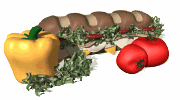
Recipes
and Italian Food History
![]()
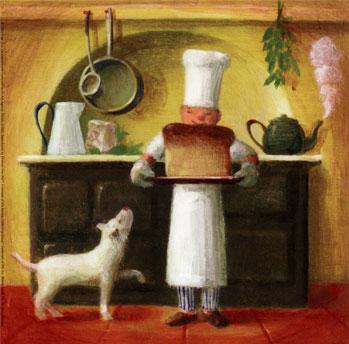 The
True Italian Cuisine and Recipes
The
True Italian Cuisine and Recipes
Gli
antipasti - Appetizers
 Antipasto
comes from Latin, meaning ‘before a meal’, but in Italy is meant
as a stuzzichino, or taste of foods that stimulate the
appetite, preparing it for the full meal.
The same recipes are used for tramezzi or piatti di
mezzo, a classic tradition of serving tasty morsels between main
dishes. Today they are
often used at receptions that require finger-food, or for light summer
meals.
Antipasto
comes from Latin, meaning ‘before a meal’, but in Italy is meant
as a stuzzichino, or taste of foods that stimulate the
appetite, preparing it for the full meal.
The same recipes are used for tramezzi or piatti di
mezzo, a classic tradition of serving tasty morsels between main
dishes. Today they are
often used at receptions that require finger-food, or for light summer
meals.La
panzanella - Bread Salad
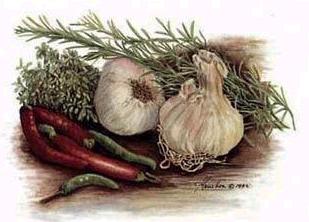 Ms.
Martelli explains that la maionese, used in some antipasti
recipes, while it is clearly an Italianization of the French word for
mayonnaise, it actually has older roots in Italian cuisine than in
French cuisine. Il
Platina describes a recipe in his 1475 cookbook for a sauce made with
eggs with lemon juice that is very similar to modern mayonnaise.
Ms.
Martelli explains that la maionese, used in some antipasti
recipes, while it is clearly an Italianization of the French word for
mayonnaise, it actually has older roots in Italian cuisine than in
French cuisine. Il
Platina describes a recipe in his 1475 cookbook for a sauce made with
eggs with lemon juice that is very similar to modern mayonnaise. Pasticcio
freddo di fegato
- Cold Liver Paste
La
pasta asciutta - Dried Pasta
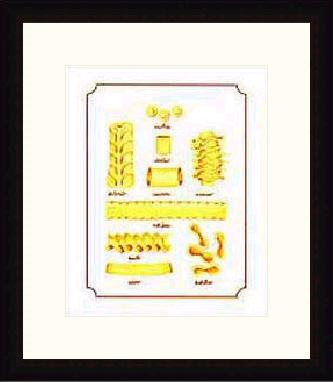 The
history in Italy of dried pasta cooked and seasoned with a sauce can
be traced as far back as the Etruscans (900 B.C.) who seasoned their
pasta with game (venison) based sauces.
This passed on to the Romans and then appears in the first
Italian cookbook in Italian, rather than Latin, by Anonimo Toscano,
from the end of the 1300’s, and published for the first time in 1963
by Francesco Zambrini. The
pasta was cooked in broth and seasoned with cheese.
The
history in Italy of dried pasta cooked and seasoned with a sauce can
be traced as far back as the Etruscans (900 B.C.) who seasoned their
pasta with game (venison) based sauces.
This passed on to the Romans and then appears in the first
Italian cookbook in Italian, rather than Latin, by Anonimo Toscano,
from the end of the 1300’s, and published for the first time in 1963
by Francesco Zambrini. The
pasta was cooked in broth and seasoned with cheese. La
besciamella
- Béchamel or White Sauce
La
pasta fatta in casa - Fresh Pasta (Homemade Pasta)
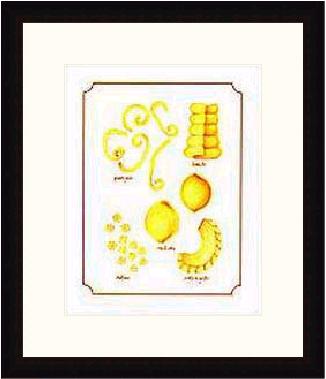 Fresh
pasta is made in sheets and cut and shaped in the various types of
pasta. It’s said that lasagna
and tagliatelle, and pasta filled with pumpkin (the earliest
fillings) are all from Ferrara. And
cappelletti, ravioli and cannoli (not the dessert cannoli) are
from Modena.
Fresh
pasta is made in sheets and cut and shaped in the various types of
pasta. It’s said that lasagna
and tagliatelle, and pasta filled with pumpkin (the earliest
fillings) are all from Ferrara. And
cappelletti, ravioli and cannoli (not the dessert cannoli) are
from Modena. Gnocchi
di spinaci / malfatti alla
fiorentina - Spinach Gnocchi / Florentine Misshapen Things
Risotto,
Minestre, Zuppe, Polenta - Rice Dishes, Stews, Soups, Polenta
Polenta
pasticciata
- Polenta Pie
Pizze,
Focacce, Torte salate - Pizzas, Flat Breads (Pizza Breads),
Savory Pies
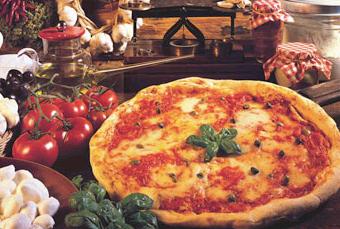 Throughout
the Mediterranean basin flat breads made of ground grains mixed with
water have been staples of the diet for centuries.
The Phoenicians, Mediterranean traders from what is now
Lebanon, passed the custom on to the people of Carthage, who were
famous for cooking focacce (risen flat breads) in terracotta
molds in the shape of flowers, fish and birds.
Greeks and Romans also used flat unrisen bread as plates,
serving the food on them, but not eating them.
Metal plates finally took the place of these mensae only
in the 14th century.
Throughout
the Mediterranean basin flat breads made of ground grains mixed with
water have been staples of the diet for centuries.
The Phoenicians, Mediterranean traders from what is now
Lebanon, passed the custom on to the people of Carthage, who were
famous for cooking focacce (risen flat breads) in terracotta
molds in the shape of flowers, fish and birds.
Greeks and Romans also used flat unrisen bread as plates,
serving the food on them, but not eating them.
Metal plates finally took the place of these mensae only
in the 14th century.  Savory
pies (torte salate) are so-called to differentiate them from
dessert tarts. Like in all European cooking cultures, the pie is very old.
In ancient English texts, the crusts (top and bottom) are
called the ‘coffin’, because of the apt comparison with burials,
the food ‘entombed’ and cooked in the oven. Recipes for savory pies appear in the oldest Italian
cookbooks, often with the popular ingredients of the day:
cinnamon, sugar, almonds and rose water.
Savory
pies (torte salate) are so-called to differentiate them from
dessert tarts. Like in all European cooking cultures, the pie is very old.
In ancient English texts, the crusts (top and bottom) are
called the ‘coffin’, because of the apt comparison with burials,
the food ‘entombed’ and cooked in the oven. Recipes for savory pies appear in the oldest Italian
cookbooks, often with the popular ingredients of the day:
cinnamon, sugar, almonds and rose water. La
torta Pasqualina -
The Easter Tart
La
carne, Il pollo, Il pesce, Piccola salumeria casalinga - Meat,
Chicken, Fish, Homemade Cured Meats
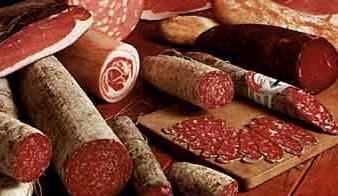 In
her discussion of the history of meat in the diet of ancient Italians,
Ms. Martelli reveals something interesting.
There are those who believe the name given to the boot-shaped
peninsula, Italia, came from the word vitulia, which means the
‘land of veal’. It
was called thus because of the massive herds of beasts that roamed the
land. Etruscans, early
inhabitants of Italy, were famous as big meat eaters.
Eventually, these wild herd were depleted (just like the
forests that covered Southern Italy, which were cut down to build
Greek ships, leaving the soil to erode into the impoverished land that
remains today).
In
her discussion of the history of meat in the diet of ancient Italians,
Ms. Martelli reveals something interesting.
There are those who believe the name given to the boot-shaped
peninsula, Italia, came from the word vitulia, which means the
‘land of veal’. It
was called thus because of the massive herds of beasts that roamed the
land. Etruscans, early
inhabitants of Italy, were famous as big meat eaters.
Eventually, these wild herd were depleted (just like the
forests that covered Southern Italy, which were cut down to build
Greek ships, leaving the soil to erode into the impoverished land that
remains today).Petto
di pollo con panna e funghi
- Chicken breasts with cream and mushrooms
Oven
Roasted Fish in Foil
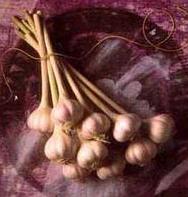 Le
verdure, La verdure sott’olio e sott’aceto, Le uova -
Vegetables, Vegetables preserved in oil and vinegar, Eggs
Le
verdure, La verdure sott’olio e sott’aceto, Le uova -
Vegetables, Vegetables preserved in oil and vinegar, EggsPatate
fritte - Fried Potatoes
 Tomatoes
came from the New World, too, and were found to grow best in the South
of Italy, especially around the Naples area, where even today they
produce the most, and best, tomatoes in the country.
Ms. Martelli says that tomatoes appear in 80 percent of all
Italian recipes, but that sounds a bit exaggerated to me.
Tomatoes
came from the New World, too, and were found to grow best in the South
of Italy, especially around the Naples area, where even today they
produce the most, and best, tomatoes in the country.
Ms. Martelli says that tomatoes appear in 80 percent of all
Italian recipes, but that sounds a bit exaggerated to me.Sformato
di spinaci - Misshapen Spinach Pie
 Beans,
despite having arrived in Italy via the New World in the 16th
century, are an integral part of Italian cuisine.
A relative of the black-eyed pea has always been eaten,
especially in Tuscany. They are used in soups, salads, and eaten on their own, most
often with a dollop of olive oil over the top.
They are a delicious winter food, warming you up for hours.
Beans,
despite having arrived in Italy via the New World in the 16th
century, are an integral part of Italian cuisine.
A relative of the black-eyed pea has always been eaten,
especially in Tuscany. They are used in soups, salads, and eaten on their own, most
often with a dollop of olive oil over the top.
They are a delicious winter food, warming you up for hours.Frittata
semplice - Simple Frittata
I
dolci, I gelati, La frutta conservata, I liquori - Desserts,
Ices, Preserved Fruit, Liquors
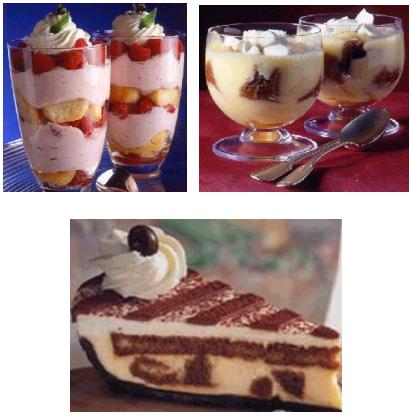 The
middle ages saw a greater influence of Arabic sweets introduced in
Sicily and then quickly spread throughout the peninsula.
These are the unleavened sweets that are often a nougat holding
together nuts and candied fruit.
Sweet breads were also popular, often cooked with raisons and
fruit.
The
middle ages saw a greater influence of Arabic sweets introduced in
Sicily and then quickly spread throughout the peninsula.
These are the unleavened sweets that are often a nougat holding
together nuts and candied fruit.
Sweet breads were also popular, often cooked with raisons and
fruit.  Crostata
Crust -
Tart Crust
Crostata
Crust -
Tart Crust
![]()

![]()
